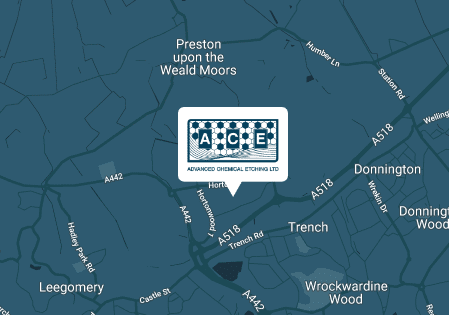Chemical ETCHING
PROCESS
What is Chemical Etching?
Highly Accurate Manufacturing
Chemical etching is a manufacturing method for producing highly complex and accurate metal components in most metals including aluminium, copper alloys, nickel alloys, titanium alloys and other exotic metals, between 0.005mm to 2.5mm thick.
More Complexity, Same Price
Many customers select chemical etching because of the flexibility it provides for supplying samples in days rather than weeks or months. The complexity of the profile does not affect the price… to process thousands of apertures or just the one, the price remains the same.
Minimum Feature Sizes
Chemical etching can achieve a minimum standard feature size of 0.075 mm, but apertures smaller than this are possible with development, as is accuracy to less than ±10% metal thickness.
Burr- And Stress-Free Chemical Etching
ACE’s chemical etch process produces parts without burrs or stress, with tolerances that can be as low as 10% of human hair. Our chemical etching process preserves the integrity of the material, even in highly complex designs.
The Benefits of Chemical Etching
-
Precise Tooling
The tooling for photochemical etching is not hard tooling but low cost, highly precise, CAD generated digital tooling (soft tooling).
-
Risk-Free Design
With the ability to produce prototypes in extremely short lead times, the complexity of design is not an issue and we can match all technical guidelines and react to design changes extremely quickly.
-
Right First Time
The chemical etching process does not use mechanical force or heat and this means that metal properties remain unchanged. A temper of material is not altered and parts are burr-free.
-
No Finishing Required
Ultimate net shape machining reduces the need for traditional finishing. Our chemical etching process leaves no rough edges or burrs.
-
Various Thickness
A variety of different materials and thicknesses can be etched in thicknesses from 0.005mm to 2.5mm.
-
Tolerances ±0.025mm
As component features are etched simultaneously, the part complexity achievable is almost limitless with accuracy to ±0.025mm.
To Bear In Mind…
Unfortunately, we are not able to put designs onto finished metal components or shaped metal items.
All of our acid etching is performed utilising perfectly flat sheets of metal.
Please also note that we are only able to chemical etch metal.
The chemical etching process is multistage and can be broken down into a series of eight steps:
1. Choosing The Metal
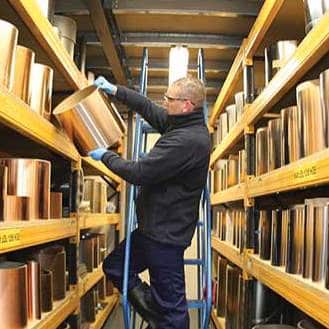
2. Metal Cleaning
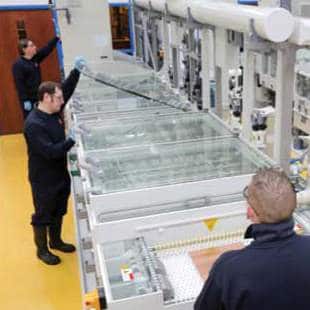
3. Lamination
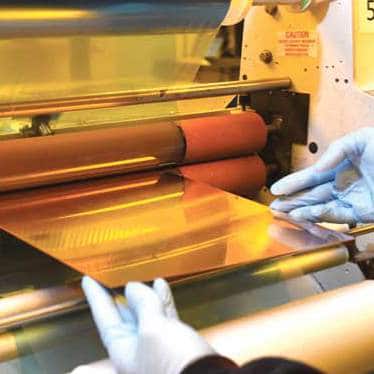
4. Printing
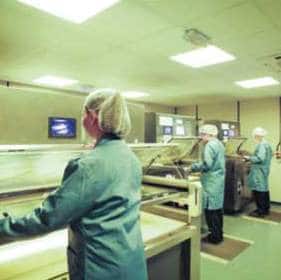
5. Developing
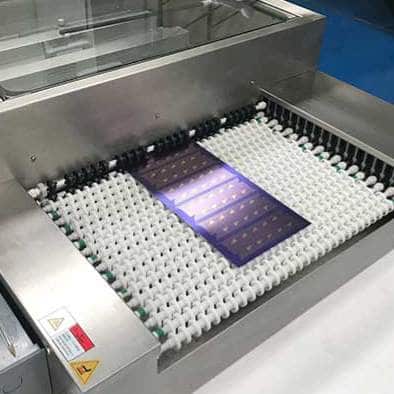
6. Etching
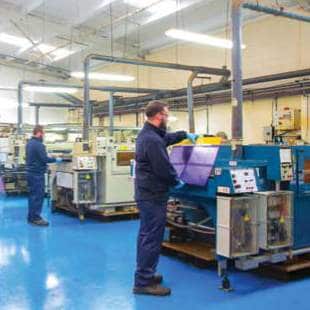
7. Stripping
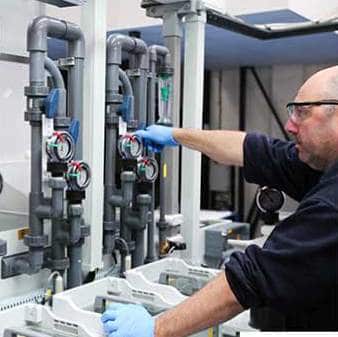
8. Inspecting & Finishing
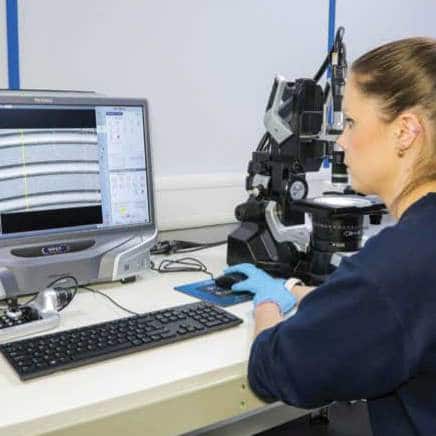
The chemical etching process is multi-stage, and can be broken down into a series of eight steps:
The Etching Process at Advanced Chemical Etching
-
Development & Evolution
We are constantly challenging the normal chemical etching process route. We continue our research into developing new, precision etching processes in our R&D laboratory. We are constantly evolving this unique process into a competitive engineering route for virtually every industry.
-
Scalable Production
Parts are supplied clean, burr and stress-free to tolerances that can be as low as 10% of human hair. The process is highly repeatable, so it is flexible enough to produce parts from one-off samples, through production ramp-up and even serial production – processing many thousands of parts every day.
-
High Capability
Tolerances are a key consideration in any design, and with chemical etching, tolerances vary dependent on the material thickness.
For metals, 0.01 mm-0.25 mm thick the minimum standard etch tolerance is ±0.025 mm.
For thicknesses above this (to 2.5mm) the minimum standard etch tolerance is ±10% metal thickness. -
Unique Etching Features
ACE can produce unique characteristics designed into products manufactured using the chemical etching process, such as logos, barcodes, text, ½ etched fold lines and surface patterns.
We can control etch profiles and, by doing so, introduce a range of profiles allowing conical openings, commonly used to direct fluid flow in filtration meshes.
Express Precision Etching
Highly precise prototypes or samples of etching products are produced rapidly through the photo/chemical etching process, allowing the design to be assessed for fit and function.
A Reputation for Service Quality
If a design change is required, the photo tooling can be altered at a minimal cost allowing optimum product development. Our reputation for service and quality leaves our competitors standing.
ACE is leading the CHEMICAL etching industry
Opportunities for Growth
ACE is leading the field when it comes to the fast-moving art of developing highly precise etched components.
We are constantly evolving and creating innovative chemical etching techniques and delivering precision metal parts, manufacturing millions of etched components per annum in different types of metals and thicknesses to global manufacturing companies across 15 different markets.
Major Industry Partners
The relationship with our customers has been a key part of our success.
By partnering with us at every stage of the design and product development process, we can help to achieve the most cost-effective, timely and accurate outcomes to customers’ design and engineering challenges.
What Industries Can Chemical Etching Be Used In?
-
Find Out More
Aerospace, Defence & Space
Quality, speed, precision and innovation are four of the key drivers that make ACE such an instrumental partner to the Aerospace and Defence sector.
-
Find Out More
Automotive & F1
The car industry and ACE date back to 2000 when the company was first formed, supplying components to tier 1 and tier 2 suppliers across the UK and Europe.
-
Find Out More
Communications & Electronics
From micro connectors for a mobile phone to a large screening can for a base station, ACE plays a significant role in connecting the world.
-
Find Out More
Precision Engineering
We are agile and responsive to fluctuating demand and innovative in our ability to deliver engineering solutions to complex problems.
-
Find Out More
Medical
ACE has invested time and money into etching titanium and is now able to deep etch and profile material for intricate medical devices.
-
Find Out More
Renewable Energy
ACE is a critical supplier to this sector, with our ability to produce specialist prototypes and low volume components has lead us to having a global clientele.
Discover Our Processes
LOW-COST TOOLING SET-UP & MODIFICATIONS
Chemical Etching Allows for Affordable Prototyping
- With photochemical etching, prices are calculated by the sheet, not by the part, which means multiple components can be processed simultaneously using a single photo tool. This ability to produce many part types in one production run is the key to the enormous cost savings inherent in the process.
- The ACE etching process can be applied to virtually any metal type, including those soft, hard or extremely brittle. For instance, aluminium is renowned for being difficult to stamp due to its soft nature or laser cut due to its reflectivity. Equally, titanium’s hardness can prove challenging for other manufacturing processes.
- ACE has developed a unique chemical etching process for both aluminium alloys and titanium and is one of the few chemical etching companies in the world with a dedicated, serial production aluminium and titanium etching capability.
- ACE lead times for manufacturing can be as low as hours as opposed to other technologies when lead times can take many months.
